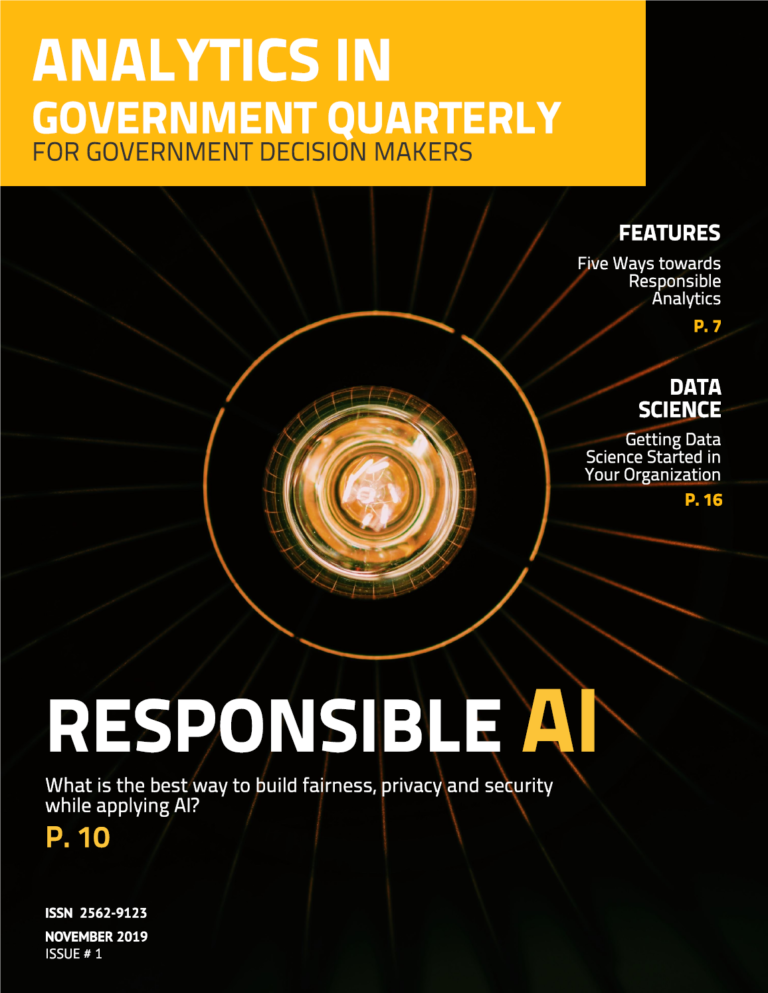FEATURES
AI, More than Just Technology
By Hubert Laferrière and Wassim EI-Kass

A little over two years ago, executive senior management at the department of Immigration, Refugees and Citizenship Canada (IRCC) approved a pilot project proposal submitted by a number of data science practitioners: launching an Advanced Analytics (AA) model to support the processing of visa applications within a business line.
The goal was to help manage the significant and constant volume increase of visa applications using Machine Learning (ML) and Advanced Analytics (AA) technologies. The idea was to triage the applications and automate some activities in the decision-making business process. The targeted business line was the visa for visitors, in particular those coming from China and India. These countries were chosen since both countries are the main sources of the demand growth and they totaled 50% of the annual volume for visa applications. If successful, processing times could be reduced while tangible benefits could be generated both for applicants and the department.
The positive decision outcome in support of the project was not a surprise to the team. In the weeks preceding the decision, the team had provided some members of the executive management team with results of the analysis and tests we had conducted. They were impressed: it was estimated that up to 35% of the volume of visa applications could have their eligibility determination automatically approved with a confidence level above 99%. Our analysis also showed that by lowering the confidence level by one percent, the volume could increase to nearly 45%. This literally made our Deputy Minister jump out of her chair.
The Challenges Below The Water
Once the decision to proceed with the pilot was announced, the team’s immediate and main concern was to identify and collect the relevant data, build predictive models, and deploy them in a production environment as a live pilot. Naively, the team considered that the substantial and significant constraints and obstacles would be mostly technical. While this was partially true, it hid, like an iceberg, the much larger submerged portion.
During the first project management meeting, a plethora of stakeholders knocked on our door raising many interesting questions, potential concerns, and issues to consider. The project team soon realized that the journey was far from being a picnic.
Even though the team knew that the disruptive & challenging technology would raise issues such as the impact on jobs, the team was surprised by their high velocity. The challenges raised were so complex and various that the team questioned whether or not the pilot could be delivered on time or was even feasible.
The challenges were overwhelming due to their diversity, touching every single aspect of the business including program integrity, legal and fairness, privacy, transparency, ethics, labor management, data governance, security, explainable AI, the methodology, and the non-traditional project management. Let’s be clear here: most of the key players involved were raising their concerns to look for solutions that would enable the pilot rather than trying to add roadblocks.
AI generates numerous debates in civil society and the “Terminator” image had a profound and symbolic effect in the minds of many. The general public has misconceptions of what AI is and makes incorrect associations with many computer technology failures. Additionally, recent mishaps such as the Phoenix government pay system and the Facebook mishandling of its users’ personal information fuel genuine concerns the public may have with IT systems in general and AI in particular when dealing with personal data.
At IRCC, the same concerns and themes had a stronger resonance: as a public organization, fundamental responsibilities and duties were to preserve and maintain procedural fairness of administrative processes and decisions, to ensure transparency and accountability, and to conform to the prescriptions of data protection and privacy laws, rules and directives. It was crucial that all applicants must be equally treated with respect. The Values and Ethics Code for the Public Sector Services are not simply statements on papers, they are a reality by which civil servants must abide.
Dealing with all the issues at the same time stunned the team: for these data science practitioners, algorithms, Advanced Analytics, Machine Learning, and AI in general, were not new technologies per se. The team was well aware of potential mishaps with harmful effects on citizens could occur. A simple mistake could generate, in a very short time, a significant volume of adverse consequences that would be difficult to repair. Although the odds are different, the risk of this happening exists with any system whether it is using AI or not.
Balancing Between Human and Machine
The team aimed at resolving the key challenges; one being to achieve the right balance to avoid stifling the development and use of the technology. The team felt sometimes that excessive measures would impede efforts to improve service to the public, optimizing business processes and generating potential savings.
At the outset, our legal team ensured that the right legal framework and authorities were in place for the use and governance of electronic systems, including automated systems. Specific ethical considerations were integrated into the establishment of the ML predictive models: only positive eligibility determinations of applications would be automated; an ongoing quality assurance of these automated determinations would be implemented; the choice of the algorithm had to allow a meaningful explanation of decisions made on client applications (as a consequence, “black box” algorithms, like neural networks, were excluded). The set of rules produced and used by the models had to be approved by the right people.
Experts from the National Research Council of Canada undertook a peer-review: they examined our methodology, approach and models to ensure measures were in place to avoid unintended bias being introduced into decision-making. A Data Readiness Assessment on data quality and governance rules was undertaken. A specialized AI training course on cyber-security was designed and implemented for data scientists. A Privacy Impact Assessment was completed and measures for enhancing privacy practices with AI were implemented.
Our policy analyst colleagues initiated the publication of a Policy Playbook to support automated decisions. The Playbook outlined guiding principles that would give a coherent basis for strategic choices about whether and how to make responsible use of new tools and techniques. Two fundamental goals were set: (1) the use of new tools should deliver a clear public benefit and (2) humans, not computer systems, are responsible for decisions. The need to curb technology arises, at least as a preventive approach or precautionary principle. The bottom line for us: guide our efforts to ensure human dignity and preserve human values.
Our first challenge is to think about how these systems will be used given their impact on individuals. The use of AA and ML at IRCC relies on a responsible design and implementation approach. Such approach recognizes the limitations and risks of data-driven technologies and recommends that humans, and algorithmic systems play complementary roles. To get the best of each, it is important to strike the right balance between the two while ensuring systems do not introduce unintended bias into decision-making. The analysis of our results shows, so far, that we are striking the right Human-Machine balance.
Generating Substantial Savings
The live pilots were successful. Since April 2018, nearly 140,000 temporary visitor visa applications from China were triaged by our pilot of which 36% were recommended for instant eligibility approval. Ongoing monitoring and quality assurance show that 99.9% of applications recommended for approval by the pilot would have been approved had the eligibility been assessed by an officer. Since the demographics are quite different, only 3% of nearly 143,000 applications received, so far, from India were recommended for instant approval.
We have assessed the impact of models on the business process: when comparing the pre- and post-pilot implementation, we had observed a significant reduction of the time required by officers to process these applications, especially for the instant eligibility approvals. A complete reversal in the proportion of staff working on low-value added versus high-value added task occurred: under AA, almost two-thirds of staff were focusing solely on decision making, rather than completing administrative tasks – tasks that are essential for quality decision making.
Although it is too early to generalize, initial analysis shows that deploying the models into a full production mode (in 2020) could generate substantial savings to the Department. The Department could, more easily, absorb pressures from the ongoing significant growth of the number of visa applications.
When the official approval of our proposal was announced, the excitement of our data scientist team was most evident. This state of mind remains today but data scientists now know their work entails more than just preparing and using data to train algorithms and build predictive models.
*Special thanks to Steven Gonzalez who managed the data science team during most of the development and deployment phases.

